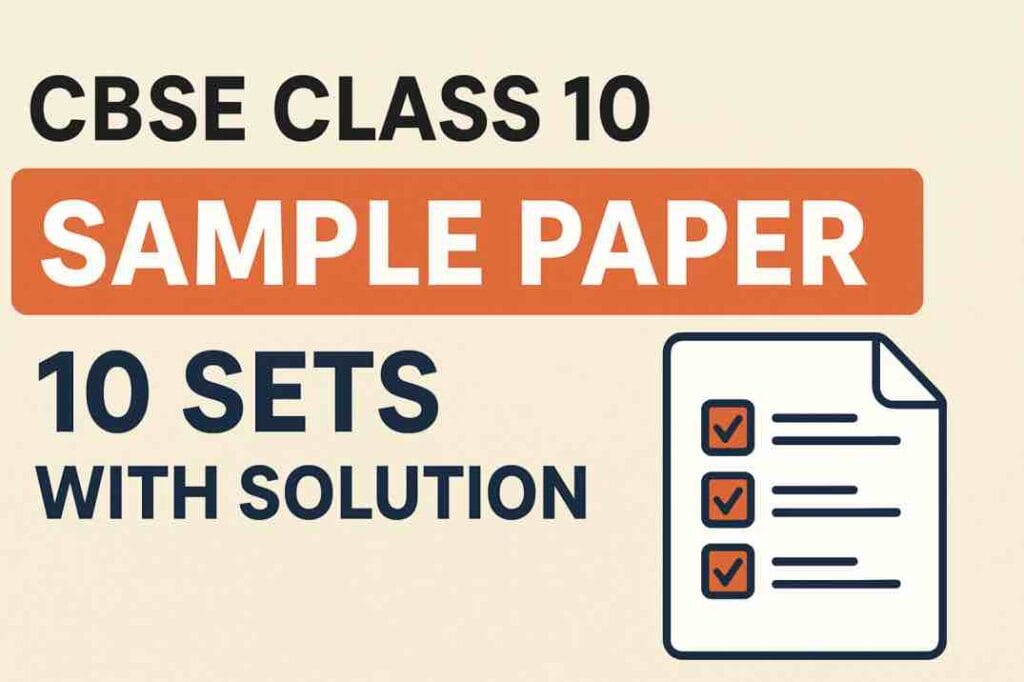📅 Published on: 22.09.2025
Table of Contents
ToggleCBSE Class 10 Hindi Sample Paper 2025-26 : 10 sets with Solution

Class 10 is one of the most crucial stages in a student’s academic journey. Among all the subjects, Hindi often plays a decisive role in boosting overall percentage because it is considered both scoring and practical. To excel in this subject, students must practice with the CBSE Class 10 Hindi Sample Paper regularly.
CBSE releases official sample papers every year to help students understand the updated exam pattern, marking scheme, and weightage of chapters. Along with the official sets, many educational experts and teachers also prepare practice sets based on the same format. When students solve these papers sincerely, they not only improve their writing skills but also develop the confidence to attempt the actual board exam efficiently.
In this article, we provide CBSE Class 10 Hindi Sample Paper download links, marking scheme, preparation tips, importance, and FAQs to make your preparation smooth and effective.
CBSE Class 10 Hindi Sample Paper Download (Course A)
The CBSE Class 10 Hindi Sample Paper (Course A) helps students understand the latest exam pattern and marking scheme. By solving these papers, students can practice comprehension, grammar, prose, and writing skills effectively. Regular practice boosts confidence, improves time management, and ensures better performance in the board exam.
Hindi (A) Sample Paper | Download Paper | Marking Scheme |
Hindi Sample Paper Set 1 | ||
Hindi Sample Paper Set 2 | ||
Hindi Sample Paper Set 3 | ||
Hindi Sample Paper Set 4 | ||
Hindi Sample Paper Set 5 | ||
Hindi Sample Paper Set 6 | ||
Hindi Sample Paper Set 7 | ||
Hindi Sample Paper Set 8 | ||
Hindi Sample Paper Set 9 | ||
Hindi Sample Paper Set 10 |
CBSE Class 10 Hindi Sample Paper Download (Course B)
The CBSE Class 10 Hindi Sample Paper (Course B) is designed for students who have Hindi as an additional or simpler subject. These papers cover grammar, comprehension, and writing skills in a balanced way. Practicing them regularly helps students understand the exam format, improve accuracy, and score higher in the final board exam.
Hindi (B) Sample Paper | Download Paper | Marking Scheme |
Hindi Sample Paper Set 1 | ||
Hindi Sample Paper Set 2 | ||
Hindi Sample Paper Set 3 | ||
Hindi Sample Paper Set 4 | ||
Hindi Sample Paper Set 5 | ||
Hindi Sample Paper Set 6 | ||
Hindi Sample Paper Set 7 | ||
Hindi Sample Paper Set 8 | ||
Hindi Sample Paper Set 9 | ||
Hindi Sample Paper Set 10 |
10th sample paper
Best Books for CBSE Class 10 Hindi Sample Paper
📘 Arihant –
Famous for I-Succeed and All-in-One series. Latest exam pattern ke hisaab se sample papers + solved/unsolved sets milte hain. Marks kaise milte hain ye samajhne ke liye best.
📕 Educart –
“Most Likely Sets” ke liye mashhoor. CBSE trend ke mutabiq questions + answer-writing sheets deta hai. Smart exam-focused practice ke liye perfect.
📙 Oswaal –
Sample papers ke saath extra help: mind maps, revision notes, competency-based questions. Jo students structured revision chahte hain unke liye useful.
📗 PW (Physics Wallah) –
Real Feel Sample Papers deta hai jisme 12 practice sets + exam-like answer sheets hote hain. Past 5 saal ka trend analysis bhi included hai. Board exam ka real experience dene ke liye best.
✨ In short:
•Arihant → Full syllabus + balanced practice
•Educart → Targeted exam sets
•Oswaal → Revision + mind maps
•PW → Real exam feel
Preparation Tips Using CBSE Class 10 Hindi Sample Paper
1. Follow a Timetable
- Consistency matters – Dedicate at least 1 hour daily specifically for Hindi. Short, regular practice is more effective than occasional long sessions.
- Simulate exam conditions – Solve at least one full sample paper twice a week within 3 hours. This helps you manage time pressure.
- Rotate sections – Focus on one weak section (grammar, writing, comprehension) each day to balance preparation.
- Include breaks – Take short 5-minute breaks every 45 minutes to keep your mind fresh and prevent burnout.
Unique idea: Create a mini “reward system” – e.g., after completing 3 papers, treat yourself to something small. This motivates consistent practice.
2. Focus on Grammar (व्याकरण)
- High-scoring yet neglected – Grammar is often skipped, but it carries easy marks.
- Practice in context – Don’t just memorize rules; solve exercises from sample papers and textbooks.
- Key topics to revise:
- Sandhi (संधि)
- Samas (समास)
- Alankar (अलंकार)
- Muhavare & Lokoktiyan (मुहावरे)
- Vakya Shuddhi (वाक्य शुद्धि)
- Make flashcards – Quick review cards for tricky rules or commonly confused items help during last-minute revision.
Unique idea: Try grammar quizzes with a friend or family member for fun revision.
3. Master the Writing Section
- Practice essays, letters, and reports – Focus on topics that frequently appear in past exams.
- Structure matters – Always divide answers into: Introduction → Body → Conclusion. Use points wherever possible for clarity.
- Sample paper mimicry – Time yourself while writing to ensure completion under exam conditions.
- Use templates – Prepare reusable templates for letters and essays (formal and informal) to save time.
Unique idea your essays aloud. It helps check flow, sentence structure, and clarity.
4. Read NCERT Textbooks Thoroughly
- Sources of most questions – Textbooks like Kshitij, Kritika, Sparsh, and Sanchayan contain the bulk of board questions.
- Solve all exercises – Don’t skip back exercises, summaries, or poems. Many questions are repeated or slightly modified in exams.
- Highlight important lines – Mark key points or quotes for quick reference.
- Relate content to sample papers – While practicing, try to see which textbook chapters each question comes from.
Unique idea: Make a “chapter-question map”: List chapters and note which type of questions (essay, letter, comprehension) usually come from them.
5. Use the Marking Scheme for Evaluation
- Check more than correctness – Compare your answers with the official marking scheme. It teaches how examiners award marks.
- Presentation counts – Learn how headings, bullet points, or short answers can improve marks.
- Refine answers – Rewrite your answers where marks were lost, focusing on clarity and completeness.
Unique idea: Maintain a “correction diary” – note common mistakes and keep track of improvements for each paper.
6. Revise Frequently
- Don’t just practice; revise – After every 4–5 papers, identify weak points (grammar mistakes, spelling errors, long answers).
- Short revision sessions – Use flashcards, mind maps, or summary sheets to quickly revise difficult topics.
- Mix old & new papers – Revisiting previous sample papers ensures you don’t forget earlier lessons.
Unique idea: Try the “teach-back method” – explain tricky topics to a friend or family member. Teaching reinforces memory better than just reading.
7. Practice Handwriting & Presentation
- Neat handwriting matters – Examiners prefer legible and well-organized answers.
- Use headings & subpoints – Helps in clarity and often earns partial marks even if the answer is incomplete.
- Time yourself – Practicing under time constraints improves neatness without slowing down.
- Highlight keywords – For essays or comprehension answers, underline important words to attract examiner attention.
Unique idea: Maintain a “presentation scorecard” – give yourself marks for neatness, headings, and clarity after each practice paper to self-evaluate.
10th Question paper
FAQs
Q1. Where can I download CBSE Class 10 Hindi Sample Paper 2025?
You can download the CBSE Class 10 Hindi Sample Paper 2025 from multiple reliable sources. The official CBSE website (cbseacademic.nic.in) provides the authentic PDFs for both Course A and Course B. These sample papers are released every year in line with the latest syllabus and exam pattern. Additionally, many trusted educational portals and publishers like Arihant, Oswaal, Educart, and PW offer downloadable sample papers and practice sets. Make sure to use official or verified sources to avoid outdated or incorrect papers.
Q2. Are CBSE Class 10 Hindi Sample Papers based on the latest syllabus?
Yes, the CBSE Class 10 Hindi Sample Papers are strictly based on the latest syllabus prescribed by CBSE. Each year, the board updates the exam pattern, marking scheme, and the distribution of questions across sections such as reading comprehension, writing, grammar, prose, and poetry. Using the updated sample papers ensures that you practice questions in the exact format you will face in the board exam. This is especially important because the board often includes competency-based questions and unseen passages, which are better understood through the latest sample papers.
Q3. How many sample papers should I solve for better preparation?
For thorough preparation, it is advisable to solve 5–10 sample papers along with previous year question papers. Regular practice helps in multiple ways:
- Time management: You learn how to allocate time to each section efficiently.
- Accuracy: Repeated practice reduces careless mistakes in grammar, comprehension, and writing sections.
- Confidence: Familiarity with question types and patterns reduces exam anxiety.
- Self-assessment: Comparing your answers with the official marking scheme helps you identify weak areas and improve presentation.





good